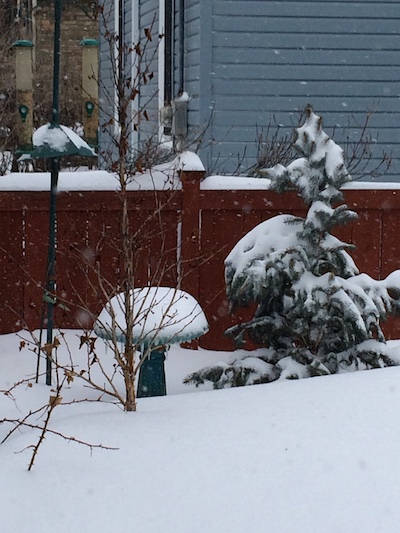As we brace ourselves for the second snowstorm of the week on top of last week’s record-setting cold, I’ve been wondering about how my plants (especially two newly planted trees) will do during the winter of 2018-2019. This has not been the perfect winter for plants — not even close.
As an experienced gardener once told me, the perfect winter for northern gardens involves “early snow, heavy snow and snow that does not melt.” That really does not describe what we have had this year—which has felt like a never-ending November followed by extreme winter the past three weeks or so.

I may be exaggerating, but if you look at the data from the Minnesota Department of Natural Resources month-by-month, you can see where the impression comes from. In October, Minnesota overall was 4.2 degrees below normal on temperature and 1.16 inches above normal on precipitation. It was also incredibly cloudy. The early part of the month was particularly cloudy and cool, ending the comfortable gardening season earlier than normal. November was, well, November, with temps averaging about 37 degrees and a typical amount of precipitation.
December continued the November effect, with temperatures all across the state running 5 or more degrees above average. We had decent precipitation, but a lot of it fell as rain or melted during some of the warm days. As a result, we came into January with a minimal amount of snow — at least in my backyard—so when it snowed a couple of inches a few days before last week’s frigid cold, I was practically cheering in the kitchen. With the extreme temperatures (-27 was the lowest low on our backyard weather monitor), it may not be enough to protect young plants, such as the Minnesota-strain redbud and Autumn Brilliance serviceberry I planted in September.
Gardeners can take some solace in a recent article by Northern Gardener contributor Lee Reich, who discusses the science of cold, and says that while plants can die in the cold, “usually that happens to garden and landscape plants pushed to their cold limits, not to native plants in their natural habitats or to well adapted exotic plants.” The redbud is definitely borderline, especially for bloom, but I’m hopeful about the serviceberry.
Can We Protect Plants?
There are a few things gardeners can do to protect plants from very imperfect winters. Choosing natives or very hardy exotics is a good first step—and probably the most important one. Mulching them in fall is also a good idea, adding an extra layer between the roots and the cold when snow is scarce. Allowing plants to prep for winter in their own way also helps. Avoiding fertilizing and pruning in the fall lets plants naturally slow down. The University of Minnesota has an informative fact sheet on winter stress factors for trees and shrubs and how to protect them.
What’s Next?

What’s ahead this winter is hard to say. Last year, we were on our way to a pretty normal winter until April, when we had nearly 30 inches of snow! Most of it fell around April 15, and it delayed spring planting in farms and gardens by several weeks. I’m grateful for the 4 inches of snow we got yesterday and the likely 6 or so we’ll get tomorrow. It may be too late, but it’s an insurance policy against further damage to young plants.
It’s interesting to hear your thoughts as an experienced northern gardener. We planted various things last summer here in Quebec, without really knowing how to think about it — the shrubs look fine (as far as we can tell under the snow) and we’ll see about the perennials when we return in late May, I suppose.
Lots of snow now here, but I don’t think there was that much until just after we arrived in early January.
Yes, it’s been a weird, weird winter here in the Midwest. I have a few plants that are borderline for zone 5a, and they may not have survived. Only time will tell. Although last year we had more subzero weather and almost no snow until April, and many of these plants survived. At least we had plenty of snow during the polar vortex. I hope your trees will be just fine.
Thanks, Beth. You seem to have gotten more snow than we did earlier in the year. (I say this having just come in from blowing out the sidewalks with about 6 inches on them!) I also have a zone 5 peach and I’m not particularly optimistic about that either!
Lisa — I’m enjoying your posts from Quebec. It’s a beautiful part of the world, but quite a change from North Carolina.